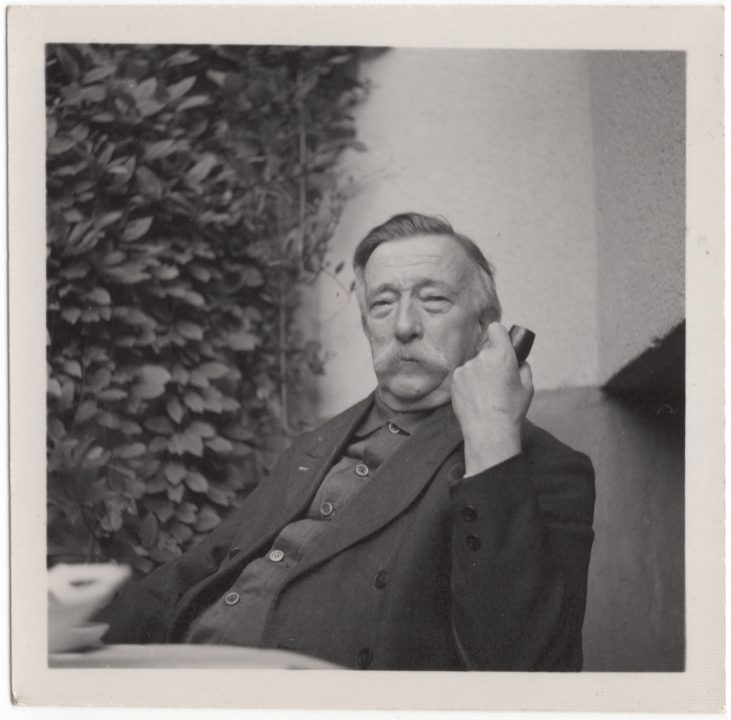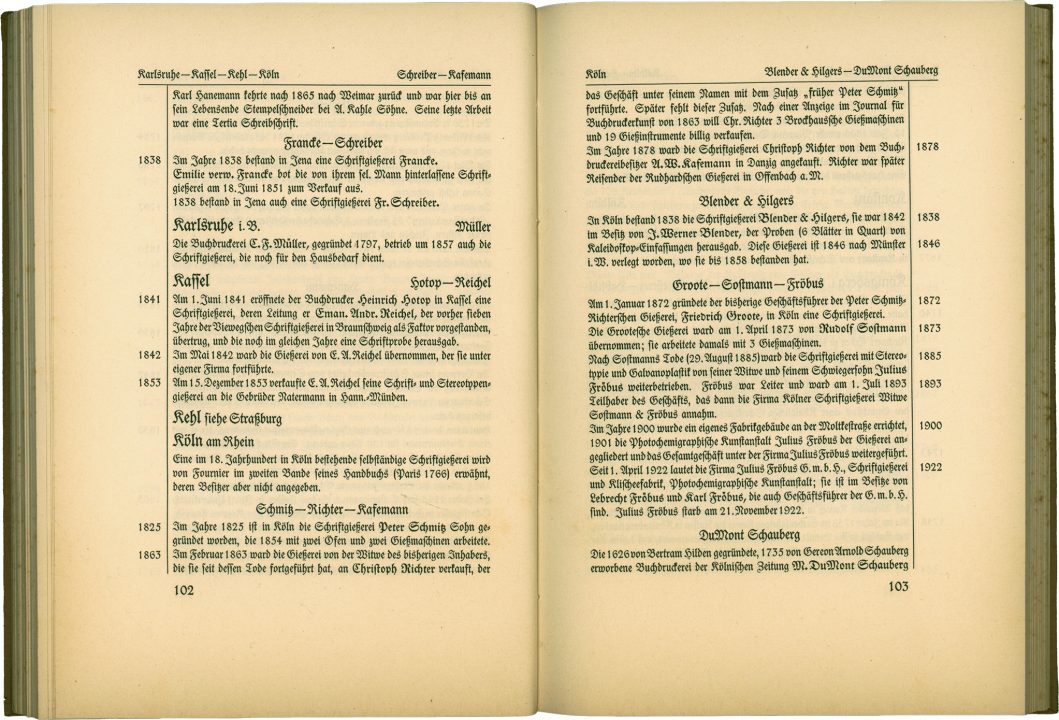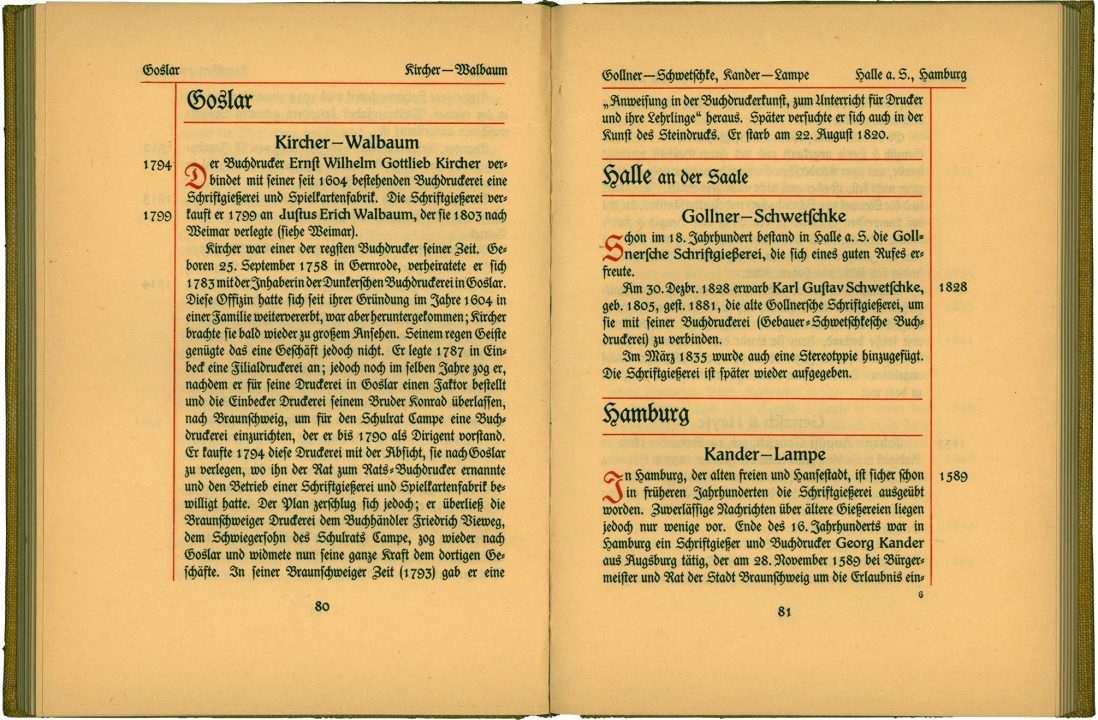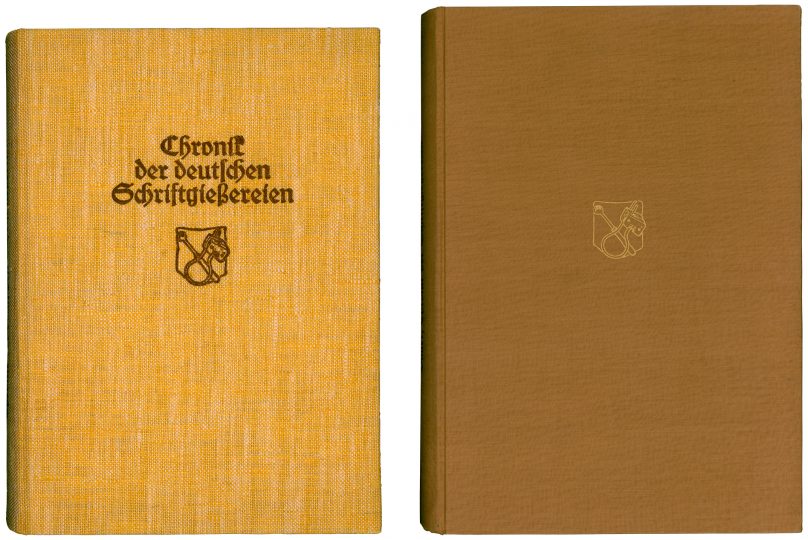One of the most helpful references for information on typefoundries active in German-speaking countries is Friedrich Bauer’s Chronik der Schriftgießereien. Its two editions – published in 1914 and 1928 – chronicle selected historical milestones of firms operating from Gutenberg until the early twentieth century. The text is not a proper narrative with contextualization, interpretation, or opinion. The Verein Deutscher Schriftgießereien – an association of German typefoundries – published the book. Essentially, that was an organization of typefoundry owners. The book is not a history of German typefaces. However, as you might expect from the organization that published it, it thoroughly lists foundries’ ownership changes and commercial successes. No author since has produced a book covering the history of the German typefoundry landscape over time in Bauer’s depth. However, more detailed books do exist for specific regions or individual firms. Bauer was behind some of those, too.

No portraits of Friedrich Bauer were published before 2020. This private photograph was taken by his daughter-in-law in the family garden at Schönberg, probably in 1940 or 1942. According to text printed on its reverse, it was developed at Foto Haas at Steinweg 6 in Frankfurt am Main. Image courtesy of Friedrich Bauer’s grandson in Kronberg im Taunus.
Friedrich Bauer (1863–1943) was a printer, author, journalist, journal editor, and type designer who worked for multiple typefoundries over several decades, including J. G. Schelter & Giesecke at Leipzig, Genzsch & Heyse at Hamburg, and J. D. Trennert & Sohn at Altona. He was not related to the punchcutters Johann Christian Bauer and Friedrich Wilhelm Bauer, who established the Bauersche Gießerei in Frankfurt in the 1830s and Bauer & Co. in Stuttgart in the 1880s, respectively. However, he was the father of Konrad F. Bauer, who had a fabled career at the Bauersche Gießerei in the 20th century. About a decade ago, Ferdinand Ulrich introduced him to a new generation of designers in an article for FontShop. In this project, I primarily focus on his historical writing. His texts form an important part of the international school of typographic history that developed in the 1920s – other writers, of course, included Germans like Ernst Crous, Gustav Mori, and Julius Rodenberg. Today, their English-language counterparts are even more well-known (Douglas McMurtrie, Stanley Morison, Daniel Berkeley Updike, Beatrice Warde, etc.).

Spread from Friedrich Bauer’s Chronik der Schriftgießereien in Deutschland und den deutschsprachigen Nachbarländern (second edition, 1928). The book, 23.7 × 17 cm when closed, was printed by the Druckerei-Gesellschaft Hartung & Co. m.b.H. in Hamburg and published by the Verein Deutscher Schriftgießereien in Offenbach am Main. It is 221 pages long. All text is set in various sizes and weights of Friedrich Bauer’s Senats-Fraktur, distributed by Genzsch & Heyse in Hamburg and Munich. This Chronik der Schriftgießereien edition is monochromatic and contains no illustrations. Click to enlarge.
Chronik der Schriftgießereien was the second edition of Bauer’s text. The Verein Deutscher Schriftgießereien publishe an earlier edition for the Internationale Ausstellung für Buchgewerbe und Graphik at Leipzig in 1914. That edition only covered typefoundries inside Germany’s 1914 political borders. The second edition not only included 14 more years of information, but also listed foundries from Austria, Bohemia, Moravia, and Switzerland. In 2011, Hans Reichardt prepared a third edition of Bauer’s text, which he published as a PDF on the Friends of the Klingspor Museum website. For that edition, Reichardt transposed the text into roman type – Sabon. He moved the additions that Bauer had placed at the back of the second edition into their alphabetical and chronological positions within the chronicle. Reichardt made Bauer’s text readily accessible to an international audience, and the searchabilty of the PDF text makes it a more useful source than printed editions of the book, which tend to sell for high prices.

Spread from Friedrich Bauer’s Chronik der deutschen Schriftgießereien (first edition, 1914). The book is slightly shorter than the second edition, measuring 22.5 × 16.5 cm when closed. It is 190 pages long, printed by Gerhard Stalling in Oldenburg, and published by the Verein deutscher Schriftgießereien in Frankfurt am Main for the occasion of the Internationale Ausstellung für Buchgewerbe und Graphik in Leipzig. The book’s text is set with Friedrich Bauer’s Senats-Fraktur. It is paired with Germanische Antiqua, a serif typeface also designed by the author that was used as the book’s secondary typeface. Both typefaces were distributed by Genzsch & Heyse in Hamburg and Munich. This edition’s printers’ rules and initials make it look both more festive and like a valuable object than its successor. Click to enlarge.
Like Mori and Updike, Friedrich Bauer trained in the printing trades, not as a historian. Several researchers have raised valid criticism of the book. For instance, in his 1986 thesis on the history of Schelter & Giesecke (Ursprung und Geschichte der Schriftgießerei J. G. Schelter & Giesecke in Leipzig), Peter Straßer highlighted that Bauer did not undertake enough primary-source research in government archives while assembling his Chronik der Schriftgießereien [Straßer p. 11]. Indeed, most of Bauer’s source material came from literary journals, newspapers, typefoundries’ own publications, and printing-trade periodicals. The exception is the book’s large section on Frankfurt am Main’s typefoundries. Gustav Mori, an employee at D. Stempel AG, had done exactly that kind of archival research needed. As Bauer wrote in his introduction to the book’s first edition, “Mori made the results of his research available for the present chronicle, [so it is] possible to offer the older Frankfurt typefoundries’ histories in considerable detail.”
Typefoundries chronicled by Friedrich Bauer
This project is a new series translating and annotating Chronik der Schriftgießereien, foundry by foundry. As I translate each entry, I will link to it from this landing page. Bauer’s chronicle can be bare bones at times. The book runs alphabetically by city name. In the second edition, he began with Altenburg in Thuringia and ended with Zürich. His foundry titles can sometimes seem like cryptic abbreviations. To cut down on the number of total posts, I’m going to place several shorter entries together. Bauer’s entry for Pierer in Altenburg is only a few lines long, while Trennert got almost three pages. So I made them part of the same post.
While “Pierer” for Johann Friedrich Pierer’s printing house in Altenburg is pretty straightforward, “Denecke – Andres – Trennert” is less so. There, he attempted to list all three names the J. D. Trennert & Sohn foundry had while it operated in Altona. The company’s first owner was Johann Heinrich Denecke. After he died, his widow married again, and Johann Balthasar Andres took over the business. When he died, his widow must have arranged for their daughter, Anna Dorothea Friedrike Denecke, to marry Johann Daniel Trennert. When Trennert’s son died in 1876, the foundry passed into the hands of the Burchhardt family, who chose not to rename the business.
Altenburg
Altona
Augsburg
- Early typefounding history
- Rainmann
- Steiner (Silicius)
- Stenglin – Berg – Göde
- Zinck – Schämaneck
- Schoch
- Herre – Adam – Sirch
- Kirchmayer
Basel
Berlin
- Thurneysser
- Königliche Schriftgießerei (Schmidt) – J. G. Francke – Tech
- Halle – Kanter
- Decker – Reichsdruckerei
- Unger – Trowitzsch
- Gubitz
- Lehmann & Mohr – Aßmann
- Haenel – Gronau
- Schneggenburger & Krumwiede
- Hayn
- Beyerhaus
- Moeser & Kühn
- Schoppe
- Theinhardt
- Fickert
- Berthold
- Ehlert – Gursch
- Zechendorf & Berthold
- Woellmer
- Produktivgenossenschaft – Reimann
- Tech
- Gebr. Arndt
- Opitz
- Reinhold – Berthold
- Verschiedene Berliner Gießereien
- Hausgießereien
- Berliner Gießmaschinen-Fabriken
[More than a hundred still to come; I’ll add more companies as I write more posts.]
